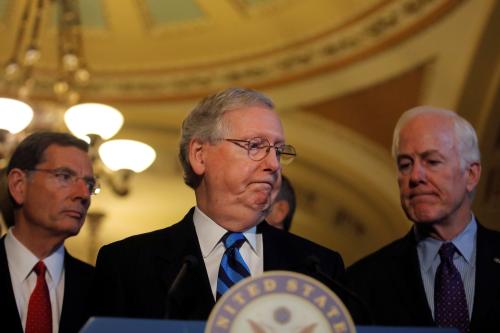This analysis is part of USC-Brookings Schaeffer Initiative on Health Policy, which is a partnership between the Center for Health Policy at Brookings and the University of Southern California Schaeffer Center for Health Policy & Economics. The Initiative aims to inform the national health care debate with rigorous, evidence-based analysis leading to practical recommendations using the collaborative strengths of USC and Brookings.
Last Thursday, Senate Republicans unveiled an updated version of the Better Care Reconciliation Act (BCRA), including a proposal from Senator Ted Cruz that would relax a range of regulations on individual market insurance plans introduced in the Affordable Care Act (ACA). While Cruz’s proposal was not included in a revised draft of the BCRA posted earlier today, the Senate’s health care negotiations remain fluid, and it appears likely that some version of the Cruz proposal will re-appear in future drafts.
Under Cruz’s proposal, insurers that offer specified plans on the ACA’s Health Insurance Marketplaces could offer plans outside the Marketplace that do not abide by various ACA requirements, notably “community rating” requirements that bar insurers from varying premiums based on health status. As I discussed in a previously published piece, under the market structure established by the Cruz amendment, many healthier people would purchase non-compliant coverage since, by virtue of insurers’ ability to vary premiums based on health status and offer skimpier coverage, that coverage would often be less expensive for them. By contrast, sicker people and many people eligible for tax credits would generally purchase coverage through the ACA-compliant market. The loss of healthier enrollees from ACA-compliant plans would put significant upward pressure on premiums for ACA-compliant plans. The rise in ACA-compliant premiums would, in turn, shift costs toward sicker enrollees and drive up the federal government’s cost of providing premium tax credits. While the Cruz amendment devotes $70 billion to insurer subsidies intended to mitigate increases in premiums for ACA-compliant plans, it is unlikely that funding would be sufficient, at least if the Cruz proposal went into effect in all states.
Some supporters of the Cruz amendment have argued that the ACA’s “single risk pool” requirement, which the Cruz amendment retains, would keep insurers from raising premiums for ACA-compliant plans to reflect the fact that many healthier enrollees would leave for non-compliant plans. In fact, while there is significant ambiguity about how the ACA’s single risk pool requirement should be interpreted in a world where community rating requirements have been partially removed, it is virtually certain that the requirement would not meaningfully constrain premiums for ACA-compliant plans. Indeed, under an approach that hews closely to HHS’ current regulatory implementation of the single risk pool requirement, the requirement would place no limits at all on the increase in ACA-compliant premiums. Alternative interpretations could constrain ACA-compliant premiums on paper, but insurers would have both strong incentives and ample opportunity to circumvent those constraints in practice.
Background on the ACA’s single risk pool requirement
Under the regulatory structure established by the ACA, insurers set premiums in two steps. First, insurers establish a base “premium rate” for each plan they offer. Second, insurers determine the premium charged to any particular individual by adjusting the plan-specific base rate to reflect individual-level factors. Under the ACA’s community rating rules, insurers can only make individual-level adjustments for geography, age, and tobacco use; the ACA also limits those adjustments in various ways.
The ACA’s single risk pool requirement governs the first step in the premium-setting process. The text of the ACA directs insurers to consider “all enrollees in all health plans…offered by such issuer in the individual market…to be members of a single risk pool.” In regulations, the Department of Health and Human Services (HHS), has interpreted this provision to mean that an insurer must set premium rates by first setting a single “index rate” that reflects its market-wide revenue requirements. The base premium rate for any particular plan is then determined by adjusting that index rate to reflect differences in expected claims costs attributable to that plan’s particular design—including the plan’s cost-sharing, network breadth, and the like—but not which types of individuals are enrolled in that plan.
In the context of the ACA, the goal of the single risk pool requirement is to ensure that plan types that are attractive to enrollees with greater health care needs do not end up having higher premiums because of that fact. Simply barring insurers from considering health status when setting premium rates for different plans would likely have been ineffective, as insurers would have had strong economic incentives to find ways to circumvent the prohibition. Thus, to align insurers’ financial incentives with the underlying regulatory goal, the ACA pairs the single risk pool requirement with a risk adjustment program that transfers money from plans with relatively healthy enrollees to plans with relatively sick enrollees.
HHS’ current single risk pool regulations would not limit increases in ACA-compliant premiums
Under the Cruz amendment, insurers who offered at least one gold plan, at least one silver plan, and at least one plan with an actuarial value of 58 percent on the Health Insurance Marketplace in a given rating area could offer non-compliant plans in that rating area that would be exempt from various ACA regulatory requirements. In particular, the Cruz amendment would exempt non-compliant plans from the ACA’s community rating rules, which bar insurers from varying premiums among enrollees in a given plan based on factors other than geography, age, and tobacco use; insurers could thus vary premiums for non-compliant plans based on any factors they wished, including health status.
As discussed in the introduction, this change, together with insurers’ ability to offer skimpier coverage in the non-compliant market, would induce many healthier enrollees to opt for non-compliant plans, while sicker enrollees would remain in ACA-compliant plans. Because the Cruz amendment would also exempt non-compliant plans from risk adjustment, there would be no risk adjustment transfers from non-compliant plans to ACA-compliant plans, so insurers would want to set premiums for ACA-compliant plans to reflect the claims costs of enrollees in ACA-compliant plans. (Making non-compliant plans subject to risk adjustment would dull this incentive, but would likely fall well short of eliminating it. This is both because risk adjustment is an inherently imperfect tool and because the wide variety of plan designs in the non-compliant market would make operating an effective risk adjustment program challenging.)
All plans would remain subject to the ACA’s single risk pool requirement under the Cruz amendment, but this requirement would not keep insurers from raising ACA-compliant premiums to match the claims costs of ACA-compliant enrollees, at least if HHS maintained its current regulatory interpretation of the requirement. In particular, HHS’s current single risk pool regulations do not limit how high an insurer can set its index rate, only how the base premium rate for each plan must be derived from the index rate. Thus, while the single risk pool requirement would continue to constrain how premiums for ACA-compliant plans must relate to one another, an insurer could set the overall level of ACA-compliant premiums as high as it wanted to by setting a high enough index rate.
Crucially, setting a high index rate would not require an insurer to set higher premiums for its non-compliant plans than it wanted to. As noted in the last section, the level of the index rate only determines the base premium rate for each plan. Because the Cruz amendment eliminates community rating for non-compliant plans, insurers could deviate from that base premium rate in any way it wished when setting premiums for particular enrollees in non-compliant plans. Thus, where an insurer decided to set its index rate would have no practical effect on pricing for its non-compliant plans.
Other approaches could limit increases in ACA-compliant premiums on paper, but not in practice
The approach outlined above is arguably the one that hews most closely to HHS’ current single risk pool regulations, and it is plausible that HHS would adopt an approach like this one if the Cruz amendment were enacted. That said, allowing ACA-compliant premiums to rise to match the claims costs of ACA-compliant enrollees is certainly incongruous with the spirit of the ACA’s single risk pool requirement.
In light of that incongruity, it is conceivable that the current administration or a future administration would seek to reinterpret the single risk pool requirement in an attempt to limit the increase in premiums for ACA-compliant plans caused by the Cruz proposal. But alternative interpretations of the single risk pool requirement would have their own unattractive features. More fundamentally, even if these interpretations limited ACA-compliant premiums on paper, insurers would have strong incentives and ample opportunity to circumvent those constraints in practice.
Alternative interpretations of the single risk pool requirement have their own unattractive features
As one approach, HHS could reinterpret the single risk pool requirement to require an insurer to set the base premium rate for each of its plans equal to its average expected costs if all its enrollees were in that plan plus a reasonable profit margin; equivalently, HHS could maintain its current regulations, but limit how high insurers could set their index rates. If this interpretation could be effectively enforced, it would indeed limit premium increases for ACA-compliant plans on paper. However, it would also force insurers to incur losses on their ACA-compliant plans, driving insurers to exit the market until competition had reached a low enough level that insurers’ profits on non-compliant plans were sufficient to compensate for these losses. It is questionable whether HHS would be willing to reinterpret the single risk pool requirement in a way that would significantly limit individual market competition.[1]
Alternatively, HHS could interpret the single risk pool requirement as requiring that the actual average premium collected vary from plan to plan based solely on plan design factors, rather than applying that requirement to the base premium rate. This interpretation, if it could be effectively enforced, would require insurers to set ACA-compliant premiums lower (and non-compliant premiums higher) than they otherwise would. However, this interpretation would also require HHS to retain a significant role in regulating premium setting for non-compliant plans. As a legal matter, retaining that role might not be consistent with the Cruz amendment’s explicit directive to eliminate community rating for those plans, and HHS might well conclude that it was undesirable on policy grounds as well.
Insurers could easily circumvent single risk pool constraints in practice
The more fundamental problem with relying on the single risk pool requirement to limit increases in ACA-compliant premiums is that insurers would have strong incentives to circumvent any pricing constraints the single risk pool requirement imposed. Because premiums for ACA-compliant policies would not reflect the claims costs of the ACA-compliant pool, insurers would incur significant losses on those policies and want to set higher premiums for these policies. Similarly, insurers would also want to find ways to set lower premiums for non-compliant policies than permitted by the single risk pool requirement.
For at least two reasons, insurers would almost certainly be successful in circumventing single risk pool constraints in practice. First, it would be difficult for regulators to verify whether insurers were, in fact, complying with the single risk pool requirement. Under any plausible interpretation of the single risk pool requirement, insurers would still be permitted to vary premiums across plans based on true differences in plan design. In many cases, it is not obvious how a particular difference in plan design should affect claims costs and different analysts will inevitably reach different judgements. That is particularly true for large differences in plan design, like those between ACA-compliant and non-compliant plans under the Cruz amendment. Thus, regulators would generally find it difficult to demonstrate that the differences between the premium rates an insurer set for its ACA-compliant and non-compliant plans reflected impermissible adjustments for differences in the health status rather than permissible adjustments for differences in plan design. As a result, making those determinations for every insurer in the market would likely be prohibitively resource-intensive, as others have noted.
Second, insurers could entirely evade the constraints imposed by the single risk pool requirement by specializing in selling either ACA-compliant or non-compliant plans or, in the case of insurers wanting to sell both types of policies, setting up two distinct subsidiaries: one to specialize in selling ACA-compliant plans and one to specialize in selling non-compliant plans. Under this strategy, insurers (or subsidiaries) specializing in selling ACA-compliant plans would sell only ACA-compliant plans. Because they would have only ACA-compliant enrollees, the single risk pool requirement would not constrain them from setting premiums that accurately reflected the risk mix of the ACA-compliant pool.
For their part, insurers (or subsidiaries) specializing in selling non-compliant plans would still be required to offer three Marketplace plans. However, insurers could design their Marketplace plans to ensure that they attracted little or no ACA-compliant enrollment. This would allow them to set their premiums for non-compliant plans based solely on the costs of enrollees in non-compliant plans despite the presence of the single risk pool requirement. Insurers could make their Marketplace plans unattractive to enrollees in many different ways. For example, an insurer could offer Marketplace plans that negotiated very high provider payment rates. Because such a plan design would legitimately be very expensive to offer, the subsidiary could set very high premiums for the plan without running afoul of the single risk pool requirement, thereby discouraging enrollees from purchasing that plan.
Indeed, it is telling that industry participants agree that single risk pool requirements could not be effectively enforced under the Cruz amendment, and thus would not mitigate increases in ACA-compliant premiums. The two largest health insurance trade associations released a joint letter on the Cruz proposal last Friday that reached precisely this conclusion. The American Academy of Actuaries released an issue brief that, although it did not directly reference the Cruz proposal, made similar arguments.
Conclusion
Insurers would have strong incentives to set premiums for ACA-compliant plans that reflected the actual claims costs of ACA-compliant enrollees under the Cruz proposal, and the fact that the Cruz amendment retains the ACA’s single risk pool requirement would place no effective constraints on insurers’ ability to do that. As a result, the Cruz amendment would put significant upward pressure on premiums for ACA-compliant plans, shifting costs toward sicker individual market enrollees and the federal government.
[1] This interpretation would also require HHS to define a “reasonable profit margin” for ACA-compliant plans. It is unclear that the single risk pool requirement empowers HHS to implement that type of outright price control.
The Brookings Institution is committed to quality, independence, and impact.
We are supported by a diverse array of funders. In line with our values and policies, each Brookings publication represents the sole views of its author(s).










Commentary
Requirement to maintain a “single risk pool” would not contain effects of Cruz’s proposal
July 20, 2017